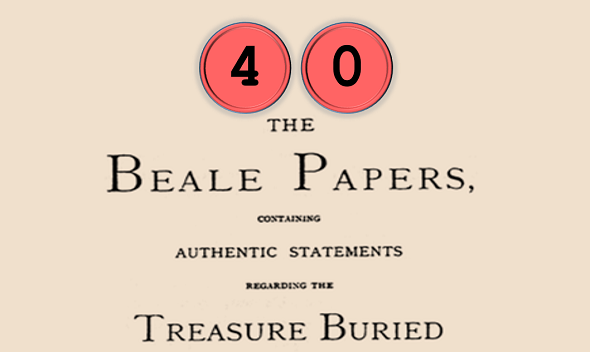Why it is a hoax
Many major crypto history experts (including David Kahn, Louis Kruh, and Craig Bauer) believe that the story of the Beale treasure including the cryptograms is a hoax. There are many good reasons for this view:
- The Ward book (i.e., a kind of trashy novel) is the only source for this story.
- It is unclear why Beale would have bothered writing three different ciphertexts for what is essentially a single message.
- Joe Nickell, a renowned forgery expert and (like me) a member of the skeptics movement, has analyzed the language of the Ward booklet and of Beale’s letters using stylometry. The result suggests that they may have been written by the same person.
- According to the Ward book, Robert Morriss was running the Washington Hotel in 1820. However, contemporary records show he did not start in that position until at least 1823.
In his Cryptologia article A Basic Probe of The Beale Cipher as a Bamboozlement, blog Louis Kruh gave a few more reasons why the Beale cryptograms are probably a fake:
Some other anomalies. After Ward received the papers from Morriss, according to his own words, he “arranged the papers in the order of their length, and numbered them. Note that the ciphers which had been identified by Ward as numbers 1, 2, and 3 contain 520, 763 and 618 elements respectively. Obviously, they are not arranged in the order of their length. Supposedly, he either made a mistake at the outset or, more likely, reversed his numbering of 2 and 3 after solving (?) what is now identified as cipher number 2 but which he probably first marked as number 3 because it was the longest of the three ciphers. The reason for the renumbering would be that the solution (?) gives the location of the treasure as being in cipher number 1 and says the names and addresses of the party are in cipher number 3. Therefore, the solved cipher becomes number 2 automatically.
Nowhere, however, does Ward indicate by what divine guidance he had been able to determine which of the two unsolved ciphers was number 1 and which was number 3. Nevertheless, his trustworthiness is apparently so beyond reproach that to this day virtually everyone accepts as an undisputed fact his labeling of one cipher as number 1 and the other as number 3.
But here are the most curious questions of all. First, how did Beale, who allegedly wrote the message found in cipher number 2, know that it would be deciphered first? Because if it wasn’t, his references to the other ciphers would not make sense. And, secondly, if he was confident it would be deci—phered first, why didn’t he refer to the other ciphers as number 2 and number 3, which would have been the normal and logical thing to do.
There’s more. For instance, a view on crypto history reveals that the cipher method used to encrypt the second note was a pretty good one for the 1820s. Almost all encryption algorithms used four decades later in the Civil War were considerably weaker. It is certainly amazing that a buffalo hunter knew this elaborate system. On the other hand, if we assume that the whole story is a fake and that this cryptogram was created in the 1880, the situation becomes completely different. In the meantime, authors like Edgar Allan Poe had made cryptography popular in the USA. The Civil War, in which encryption played an important role, had made many soldiers familiar with ciphers. After the presidential election of 1876, US newspapers reported on their title pages about hundreds of encrypted telegrams sent by the candidate’s supporters in order to manipulate the outcome of the election. All this means that in the 1880s many Americans were well informed enough about cryptology to know and use such a cipher.



Kommentare (13)